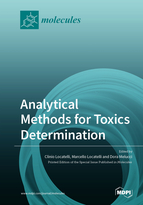Analytical Methods for Toxics Determination
A special issue of Molecules (ISSN 1420-3049). This special issue belongs to the section "Analytical Chemistry".
Deadline for manuscript submissions: closed (29 February 2020) | Viewed by 30984
Special Issue Editors
Interests: analytical methods set up; environmental field; food contaminants; spectroscopy; voltammetry
Special Issues, Collections and Topics in MDPI journals
Interests: innovative (micro)extraction procedures; hyphenated instrument configurations; bioactive compounds; characterization; fingerprints; method validation; HPLC; mass spectrometry; biological matrices; chromatography; analytical chemistry; sample preparation; green analytical methodologies
Special Issues, Collections and Topics in MDPI journals
Interests: chemometrics; environmental chemistry; forensics; food chemistry; pharmaceutics
Special Issues, Collections and Topics in MDPI journals
Special Issue Information
Dear Colleagues,
In recent decades, but especially in recent years, the rapid spread of toxic species has occurred in all matrices. Evidently, these contaminants, both of inorganic and organic origin, are very dangerous pollutants for human health, owing to their bioaccumulation and toxicity. They come from almost all human activities, such as, for example, industries, agriculture, vehicular traffic, and urban heating.
Considering that often these species occur in the various real matrices at extremely low concentrations, the analytical methodologies must evidently show their possible application by verifying the correctness of all the steps: sampling, sample preparation, instrumental measurement, and statistical data processing.
Another extremely important aspect concerns the fact that the development of new analytical methodologies, and the contemporary lack or inadequacy of regulations regarding the determination of toxic species in the most varied matrices, can obviously give to the legislator the possibility to update and improve the above-mentioned regulations.
This Special Issue aims to attract contributions on all aspects linked to the different analytical methods used for the determination of toxic species in the most varied matrices—food, environmental, forensic, biological, and so on—focusing particularly on the fundamental parameters of interest to set-up an analytical procedure, such as precision and trueness (that together give accuracy); the limits of detection and quantification; selectivity; and, especially, sensitivity.
Prof. Dr. Clinio Locatelli
Prof. Marcello Locatelli
Prof. Dora Melucci
Guest Editors
Manuscript Submission Information
Manuscripts should be submitted online at www.mdpi.com by registering and logging in to this website. Once you are registered, click here to go to the submission form. Manuscripts can be submitted until the deadline. All submissions that pass pre-check are peer-reviewed. Accepted papers will be published continuously in the journal (as soon as accepted) and will be listed together on the special issue website. Research articles, review articles as well as short communications are invited. For planned papers, a title and short abstract (about 100 words) can be sent to the Editorial Office for announcement on this website.
Submitted manuscripts should not have been published previously, nor be under consideration for publication elsewhere (except conference proceedings papers). All manuscripts are thoroughly refereed through a single-blind peer-review process. A guide for authors and other relevant information for submission of manuscripts is available on the Instructions for Authors page. Molecules is an international peer-reviewed open access semimonthly journal published by MDPI.
Please visit the Instructions for Authors page before submitting a manuscript. The Article Processing Charge (APC) for publication in this open access journal is 2700 CHF (Swiss Francs). Submitted papers should be well formatted and use good English. Authors may use MDPI's English editing service prior to publication or during author revisions.
Keywords
- Inorganic toxic species
- Organic toxic species
- Analytical methods
- Chemometrics
- Practical applications.









